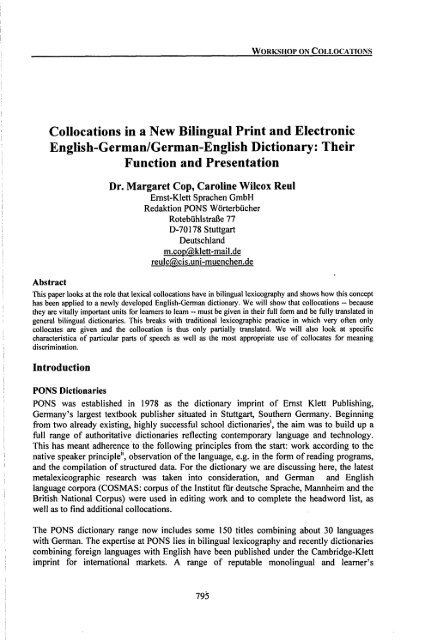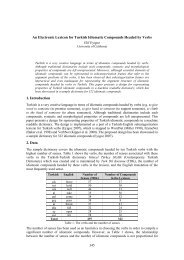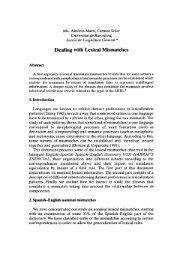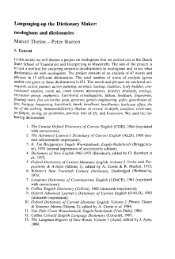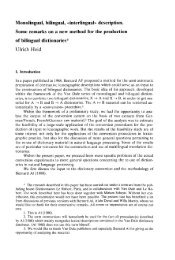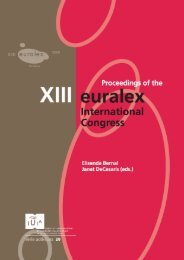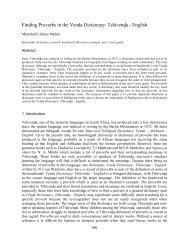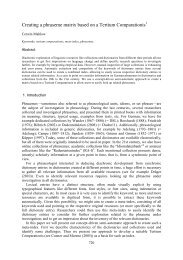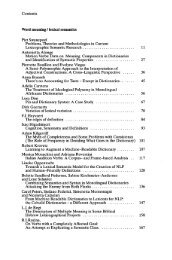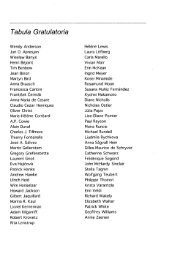Collocations in a New Bilingual Print and Electronic English - Euralex
Collocations in a New Bilingual Print and Electronic English - Euralex
Collocations in a New Bilingual Print and Electronic English - Euralex
You also want an ePaper? Increase the reach of your titles
YUMPU automatically turns print PDFs into web optimized ePapers that Google loves.
WORKSHOP ON COlXOCATtONS<br />
<strong>Collocations</strong> <strong>in</strong> a <strong>New</strong> Bil<strong>in</strong>gual Pr<strong>in</strong>t <strong>and</strong> <strong>Electronic</strong><br />
<strong>English</strong>-German/German-<strong>English</strong> Dictionary: Their<br />
Function <strong>and</strong> Presentation<br />
Dr. Margaret Cop, Carol<strong>in</strong>e Wilcox Reul<br />
Ernst-Klett Sprachen GmbH<br />
Redaktion PONS Wörterbücher<br />
Rotebühlstraße 77<br />
D-70178Stuttgart<br />
Deutschl<strong>and</strong><br />
m.cop@klett-mail.de<br />
reulc@cis.uni-muenchen.de<br />
Abstract<br />
This paper looks at the roIe that lexical collocations have <strong>in</strong> bil<strong>in</strong>gual lexicography <strong>and</strong> shows how this concept<br />
has been applied to a newly developed <strong>English</strong>-German dictionary. We will show that collocations -- because<br />
they are vitally important units for learners to learn - must be given <strong>in</strong> their full form <strong>and</strong> be fully translated <strong>in</strong><br />
general bil<strong>in</strong>gual dictionaries. This breaks with traditional lexicographic practice <strong>in</strong> which very often only<br />
collocates are given <strong>and</strong> the collocation is thus only partially translated. We will also look at specific<br />
characteristica of particular parts of speech as well as the most appropriate use of collocates for mean<strong>in</strong>g<br />
discrim<strong>in</strong>ation.<br />
Introduction<br />
PONS Dictionaries<br />
PONS was established <strong>in</strong> 1978 as the dictionary impr<strong>in</strong>t of Ernst Klett Publish<strong>in</strong>g,<br />
Germany's largest textbook publisher situated <strong>in</strong> Stuttgart, Southern Germany. Beg<strong>in</strong>n<strong>in</strong>g<br />
from two already exist<strong>in</strong>g, highly successful school dictionaries', the aim was to build up a<br />
full range of authoritative dictionaries reflect<strong>in</strong>g contemporary language <strong>and</strong> technology.<br />
This has meant adherence to the follow<strong>in</strong>g pr<strong>in</strong>ciples from the start: work accord<strong>in</strong>g to the<br />
native speaker pr<strong>in</strong>ciple", observation ofthe language, e.g. <strong>in</strong> the form ofread<strong>in</strong>g programs,<br />
<strong>and</strong> the compilation of structured data. For the dictionary we are discuss<strong>in</strong>g here, the latest<br />
metalexicographic research was taken <strong>in</strong>to consideration, <strong>and</strong> German <strong>and</strong> <strong>English</strong><br />
language corpora (COSMAS: corpus ofthe Institut für deutsche Sprache, Mannheim <strong>and</strong> the<br />
British National Corpus) were used <strong>in</strong> edit<strong>in</strong>g work <strong>and</strong> to complete the headword list, as<br />
well as to f<strong>in</strong>d additional collocations.<br />
The PONS dictionary range now <strong>in</strong>cludes some 150 titles comb<strong>in</strong><strong>in</strong>g about 30 languages<br />
with German. The expertise at PONS lies <strong>in</strong> bil<strong>in</strong>gual lexicography <strong>and</strong> recently dictionaries<br />
comb<strong>in</strong><strong>in</strong>g foreign languages with <strong>English</strong> have been published under the Cambridge-Klett<br />
impr<strong>in</strong>t for <strong>in</strong>ternational markets. A range of reputable monol<strong>in</strong>gual <strong>and</strong> learner's<br />
795
EURALEX 2002 PROCEEDINGS<br />
dictionaries from publish<strong>in</strong>g houses such as Cambridge University Press, Le Robert <strong>and</strong><br />
Zanichelli is also available under the PONS impr<strong>in</strong>t.<br />
The new l<strong>in</strong>e of large-scale corpus-validated German-<strong>English</strong> PONS dictionaries was<br />
compiled by an <strong>in</strong>ternational team of some 60 experts <strong>and</strong> published <strong>in</strong> the late summer of<br />
2001. In our paper we will refer to the largest one: PONS Großwörterbuch Englisch [PGE<br />
2001], a general bil<strong>in</strong>gual dictionary with some 350,000 headwords <strong>and</strong> phrases. Our<br />
examples all stem from the <strong>English</strong>-German side because we are look<strong>in</strong>g at the production<br />
aspect for speakers of <strong>English</strong> <strong>in</strong> order to reach a larger public. The same pr<strong>in</strong>ciples would<br />
apply to a view of the German-<strong>English</strong> side from the po<strong>in</strong>t of view of production by the<br />
German user. We are bas<strong>in</strong>g our def<strong>in</strong>ition <strong>and</strong> general view of collocations on the work of<br />
Franz Josef Hausmann [as resummarized <strong>in</strong> 1997]. The specific view of collocations <strong>in</strong><br />
bil<strong>in</strong>gual lexicography is based on Cop [1990; 1991].<br />
Multi-word Units <strong>in</strong> PGE Typography<br />
Because each k<strong>in</strong>d ofmulti-word unit has a different status, it makes sense to treat each type<br />
differently on a typographic level. Thus, phrasal verbs each beg<strong>in</strong> a new l<strong>in</strong>e <strong>and</strong> are<br />
preceded by a black lozenge. The symbol ~ <strong>in</strong>dicates that the sequence of object <strong>and</strong><br />
complement is <strong>in</strong>terchangeable.<br />
• dry off...v/... to dry sth/sb/oneself ~ ofFjdn/etw/sich akk abtrocknen;<br />
Grammatical constructions, as the follow<strong>in</strong>g examples show, are <strong>in</strong> semi-bold <strong>and</strong> identified<br />
by a preced<strong>in</strong>g shaded square:<br />
glance ... v/... Bto~ at sth aufetw•••schauen;<br />
hold ... ví... • to~sb/sthjdn/etwtragen;<br />
Lexical <strong>and</strong> grammatical collocations are generally given <strong>in</strong> full <strong>and</strong> <strong>in</strong> semi-bold. We will<br />
discuss exceptions to this later on <strong>in</strong> the paper.<br />
nose ... n... to blow one's ~ sich die Nase putzen;<br />
utter ... vt ... to ~ a curse/threat e<strong>in</strong>en Fluch/e<strong>in</strong>e Drohung ausstoßen; to ~ a diatribe e<strong>in</strong>e<br />
Schmährede halten; to ~ a falsehood e<strong>in</strong>e Unwahrheit sagen; to ~ an <strong>in</strong>cantation e<strong>in</strong>en Zauberspruch<br />
aufsagen; to ~ an oath e<strong>in</strong>en Eid schwören; to ~ a prayer e<strong>in</strong> Gebet sprechen; to ~ a warn<strong>in</strong>g e<strong>in</strong>e<br />
Warnung aussprechen; without ~<strong>in</strong>g a word ohne e<strong>in</strong> Wort zu sagen;<br />
Example sentences appear <strong>in</strong> semi-bold italics.<br />
picture ... n ... Ihate hav<strong>in</strong>g my ~ taken ich hasse es, fotographiert zu werden;<br />
co<strong>in</strong>cidence ... n ... Whata~!was fflre<strong>in</strong>Zufall!;<br />
Idioms are listed under the head<strong>in</strong>g "pHRASEs:" at the end of the relevant part of speech<br />
category for the headword under which they are entered. The base word of the idiom is<br />
underl<strong>in</strong>ed for quicker access.<br />
796
WORKSHOP ON COLLOCATIONS<br />
míss ... v/ ... PHRASES: to ~ the boat (<strong>in</strong>f: not take advantage) den Anschluss verpassen tfail to<br />
underst<strong>and</strong>) etw nicht mitbekommen; to ~ the bus den Anschluss verpassen; to ~ the mark das Ziel<br />
[o den Zweck] verfehlen; to ~ the po<strong>in</strong>t nicht verstehen, worum es geht; to not ~ a trick alle Register<br />
ziehen;<br />
<strong>Collocations</strong> with<strong>in</strong> the Framework ofMulti-Word Units<br />
<strong>Collocations</strong> are only one type of multi-word unit (MWU), which also <strong>in</strong>cludes free<br />
comb<strong>in</strong>ations <strong>and</strong> compounds. Thus, exam<strong>in</strong><strong>in</strong>g collocations with<strong>in</strong> the context ofMWUs <strong>in</strong><br />
general sheds light not only their role for the foreign language speaker but also their<br />
treatment <strong>in</strong> the bil<strong>in</strong>gual dictionary. As an ambiguous term, we would like to def<strong>in</strong>e <strong>and</strong><br />
contrast collocations with other MWUs by describ<strong>in</strong>g the def<strong>in</strong><strong>in</strong>g features of each, based on<br />
the work ofHausmann <strong>and</strong> Günthnerßilanco, as summarized below.<br />
<strong>Collocations</strong> <strong>and</strong> Free Comb<strong>in</strong>ations<br />
A free comb<strong>in</strong>ation consists oftwo lexical units, <strong>in</strong> which one modifies or restricts the other.<br />
They generally consist ofwords which Hausmann [1997] has called autosemantic elements,<br />
i.e. words which can easily be def<strong>in</strong>ed <strong>and</strong> understood without a co-text. In general, such<br />
comb<strong>in</strong>ations pose no trouble to the language learner as the translation from L1 to L2 can<br />
generally be literal, one word at a time.<br />
1. Eng.: clean air, h<strong>and</strong>s, water, face, shirt<br />
Ger.:saubereLuft/H<strong>and</strong>e, sauberes Wasser/Gesicht/Hemd<br />
<strong>Collocations</strong>, however, though also bipartite units, display an <strong>in</strong>ner relationship between the<br />
<strong>in</strong>dividual lexical units, which may be broken down <strong>in</strong>to two roles, the base <strong>and</strong> the<br />
collocator. The base ofthe collocation is the more transparent word, one that <strong>in</strong> <strong>and</strong> ofitself<br />
can be understood <strong>and</strong> as such is easy to transpose <strong>in</strong>to L2. The word that is more difficult to<br />
translate is called the collocator. Whereas the base is usually autosemantic 1 ", the collocator is<br />
usually synsemantic fHausmann 1997]. This is a word that requires a context partner <strong>in</strong> order<br />
for it to be understood. Compare example 1 above with the follow<strong>in</strong>g example:<br />
2. Eng.: a clean driv<strong>in</strong>g license, to have a clean record.<br />
Ger.: e<strong>in</strong> Führersche<strong>in</strong> ohne Strafpunkte <strong>and</strong> nicht vorbestraft se<strong>in</strong>.<br />
In example 2, a beg<strong>in</strong>n<strong>in</strong>g GFL speaker would probably translate the <strong>English</strong> collocator,<br />
clean, <strong>in</strong>to the German equivalent, sauber. A more experienced speaker would probably<br />
suspect that sauber was not correct, but would still not be able to produce the correct phrase<br />
[see Hausmann 1993]. Example 1 does not belong <strong>in</strong> the bil<strong>in</strong>gual dictionary- except for <strong>in</strong><br />
the case of mean<strong>in</strong>g differentiation <strong>and</strong> then only <strong>in</strong> an abbreviated version, whereas<br />
example 2 can't be done without.<br />
Before cont<strong>in</strong>u<strong>in</strong>g, it is important to note that some free comb<strong>in</strong>ations must be treated as<br />
collocations <strong>in</strong> the bil<strong>in</strong>gual dictionary when they pose significant difficulties <strong>in</strong> production<br />
[Cop 1990]. On the other h<strong>and</strong>, some collocations are realized <strong>in</strong> L1 <strong>and</strong> L2 <strong>in</strong> the same<br />
manner. As such they are of secondary importance <strong>in</strong> bil<strong>in</strong>gual dictionaries. This<br />
797
EURALEX 2002 PROCEEDINGS<br />
qualification is apparent throughout the criteria for <strong>in</strong>clud<strong>in</strong>g collocations <strong>in</strong> PGE, with few<br />
exceptions which are noted later on <strong>in</strong> the paper.<br />
An additional factor that dist<strong>in</strong>guishes a collocation from a free comb<strong>in</strong>ation concerns lexical<br />
function, which Gi<strong>in</strong>thner <strong>and</strong> Blanco describe <strong>in</strong> detail [2002]. A free comb<strong>in</strong>ation can be<br />
expressed as a simple predication as <strong>in</strong> example 3:<br />
3. complete set ^ set(complete), a set which has the quality ofbe<strong>in</strong>g complete.<br />
4. complete fool ^ *fool(complete) a fool who has the quality ofbe<strong>in</strong>g complete ??.<br />
The collocation <strong>in</strong> example 4 is obviously different from the free comb<strong>in</strong>ation <strong>in</strong> example 3,<br />
<strong>in</strong> that "complete," rather than hav<strong>in</strong>g an explicit mean<strong>in</strong>g, serves as an <strong>in</strong>tensifier which can<br />
be expressed by the lexical function, <strong>in</strong>tensity [Mel'cuk 1995] 1V , which can be noted as<br />
follows: <strong>in</strong>tensity(fool) => complete - when the lexical function, <strong>in</strong>tensity, is applied to<br />
"fool" the collocation, completefool, results\ Because the lexical function <strong>and</strong> not the<br />
<strong>in</strong>dividual components of the collocation must be translated, the foreign language speaker<br />
requires a full translation of the collocation <strong>in</strong> the bil<strong>in</strong>gual dictionary. Here are several<br />
similar examples:<br />
complete ... adj... ~ fool Vollidiot;<br />
absolute ... adj... to talk ~ nonsense kompletten Uns<strong>in</strong>n reden;<br />
utter ... adj... an ~ waste of time e<strong>in</strong>e totale Zeitverschwendung;<br />
Though, as mentioned above, relevance to the L2 speaker supercedes the systematic list<strong>in</strong>g<br />
of lexical functions or collocations, these are often difficult for learners. Lexical functions<br />
appear to be especially notable <strong>in</strong> adverb collocations, which seem to have a very fixed,<br />
strongly pre-fabricated quality to them, or <strong>in</strong> Benson's words, they "spr<strong>in</strong>g readily to m<strong>in</strong>d"<br />
[Benson et al 1986]. They are often quite restricted, although semi-transparent.<br />
conveniently ... adv... ~ located günstig gelegen;<br />
completely ... adv... ~ certa<strong>in</strong> absolut sicher;<br />
commercially ... adv... ~ available im H<strong>and</strong>el erhältlich;<br />
accutely ... adv... to be ~ aware ofsth sich dat e<strong>in</strong>er S. gen sehr bewusst se<strong>in</strong>;<br />
adamantly ... adv... to be ~ opposed to sth etw entscheidend ablehnen;<br />
carefully ... adv ...to listen~aufmerksam zuhören;<br />
<strong>Collocations</strong>, Compounds <strong>and</strong> Idioms<br />
On the other h<strong>and</strong>, as multi-word expressions, collocations are not as fixed as idioms or<br />
compounds, which can be considered "lexically atomic" units [Günthner & Blanco 2002].<br />
These are not analysable on any level nor can they be readily modified, as several examples<br />
from Günthner <strong>and</strong> Blanco [2002] show. In example 5 below, both the collocation <strong>and</strong> the<br />
free comb<strong>in</strong>ation can be modified, whereas the compound cannot.<br />
798
Compound:<br />
Free Comb<strong>in</strong>ation:<br />
Collocation:<br />
5. (modification)<br />
6. (coord<strong>in</strong>ation)<br />
Big Bus<strong>in</strong>ess<br />
big house<br />
big decision<br />
*very Big Bus<strong>in</strong>ess<br />
very big house<br />
very big decision<br />
*Big <strong>and</strong> important Bus<strong>in</strong>ess<br />
big <strong>and</strong> spacious home<br />
big <strong>and</strong> important decision<br />
WORKSHOP OM COLLOCATIONS<br />
Analogous to the dist<strong>in</strong>ction between compounds <strong>and</strong> free comb<strong>in</strong>ations <strong>and</strong> collocations, is<br />
the difference between idioms <strong>and</strong> collocations. As above, idioms cannot be modified [see<br />
Schenk 1992], whereas the collocation can.<br />
Idiom:<br />
Collocation:<br />
to kick the bucket<br />
to kick a habit<br />
7. (passivization) *the bucket was kicked<br />
the habit was kicked<br />
8. (topicalization) *the bucket she kicked ..<br />
the habit she kicked ...<br />
These selected examples of modification tests that can be applied to both compounds <strong>and</strong><br />
idioms show<strong>in</strong>g that they encompass one s<strong>in</strong>gle unit should suffice to demonstrate their<br />
dist<strong>in</strong>ction from collocations. In PGE, compounds are given headword status, while idioms<br />
are treated separately <strong>in</strong> "phrases" section at the end ofthe entry as described <strong>in</strong> section 1.<br />
above.<br />
Criteria for Includ<strong>in</strong>g <strong>Collocations</strong> <strong>in</strong> the Dictionary<br />
Units to Learn<br />
Hausmann [1993] has shown that collocations must be learned as a whole <strong>and</strong> calls them,<br />
together with constructions <strong>and</strong> idioms "Formulierungen" ("formulations").. They are a<br />
common source oferror <strong>in</strong> L2 because learners tend to transpose L1 collocations directly<br />
<strong>in</strong>to L2. This assumes that each element is autosemantic, but collocations, as we have seen,<br />
consist of a synsemantic <strong>and</strong> an autosemantic component. They must be identified as items<br />
to be learned especially for encod<strong>in</strong>g purposes because underst<strong>and</strong><strong>in</strong>g a collocation is easier<br />
than reproduc<strong>in</strong>g it from memory. <strong>Collocations</strong> that are difficult to translate must be<br />
<strong>in</strong>cluded <strong>in</strong> bil<strong>in</strong>gual dictionaries.<br />
possess ... vt... to ~ charm Charme haben [o besitzen]; to ~ dignity voller Würde se<strong>in</strong>; to ~ magical<br />
powers über magische Kräfte verfügen; to ~ special skills besondere Fähigkeiten besitzen;<br />
799
EURALEX 2002 PROCEEDINGS<br />
produce ... vt ... to ~ antibodies/red blood cells Antikörper/rote Blutkörperchen produzieren; to ~<br />
coaĽoil KohleAirdöl fordern; to ~ electricity Strom erzeugen; to ~ ideas/thoughts Ideen/Gedanken<br />
entwickeln; to ~ an illusion e<strong>in</strong>e falsche Vorstellung erwecken; to ~ noise Lärm verursachen; to ~ a<br />
noveMreport e<strong>in</strong>en Romar^Bericht schreiben [o verfassen]; to ~ an odour e<strong>in</strong>en Geruch absondern;<br />
to ~ a shadow e<strong>in</strong>en Schatten werfen; to ~ a state of hypnosis e<strong>in</strong>en Hypnosenzust<strong>and</strong><br />
herbeifflhren;<br />
Other collocations have an idiomatic feel to them but are very easy to translate. We <strong>in</strong>clude<br />
a selection ofthese <strong>in</strong> the dictionary:<br />
produce ... v/ ... to ~ top artists Spitzenkunstler[<strong>in</strong>nen] produzieren; to ~ a record/CD e<strong>in</strong>e<br />
CD/Schallplatte produzieren;<br />
piece... n... to break/smash/tear sth <strong>in</strong> [or <strong>in</strong>to] [or to] ~s etw <strong>in</strong> Stücke brechen/schlagen/reißen;<br />
question<strong>in</strong>g... adj... a ~ look e<strong>in</strong> fragender Blick;<br />
Degree ofRestrictedness<br />
<strong>Collocations</strong> can be more or less restricted: moot question, confirmed bachelor, adamant<strong>in</strong>e<br />
will, addled eggsfbra<strong>in</strong> are far more restricted than utter nonsense, high hopes, assorted<br />
flavors or healthy lifestyle which have a larger collocational range. The more restricted a<br />
collocation is, the more important it is to <strong>in</strong>clude it.<br />
wound ... adj ... a gap<strong>in</strong>g/open ~ e<strong>in</strong>e klaffende/offene Wunde; (a bleed<strong>in</strong>g/<strong>in</strong>fected/old ~ all not<br />
<strong>in</strong>cluded)<br />
confirmed ... adj ... a ~ alcoholic chronischer Alkoholiker; a ~ atheist e<strong>in</strong> überzeugter Atheist: a ~<br />
bachelor e<strong>in</strong>gefleischter Junggeselle; (a ~ reservation is not <strong>in</strong>cluded)<br />
recover ... vt... fóet back) one 's health etw zurückerlangen; sth lent etw zurückbekommen; one 's<br />
appetite etw wiedergew<strong>in</strong>nen; stolen goods etw sicherstellen; to ~ one's balance/composure se<strong>in</strong><br />
Gleichgewicht/se<strong>in</strong>e Selbstbeherrschung wieder f<strong>in</strong>den; to ~ consciousness das Bewusstse<strong>in</strong><br />
wiedererlangen, wieder zu Bewusstse<strong>in</strong> kommen; to ~ one's costs se<strong>in</strong>e Kosten decken; to ~ data/a<br />
directory/file COMPUT Daten/ e<strong>in</strong> Verzeichnis/ e<strong>in</strong>e Datei wiederherstellen; to ~ one's health wieder<br />
gesund werden; to ~ one's hear<strong>in</strong>g/sight wieder höraVsehen können; to ~ one's strength wieder zu<br />
Kräften kommen;<br />
The example, recover, shows various degrees of restrictedness <strong>and</strong> their representations <strong>in</strong><br />
PGE. Whereas lexical fields are written <strong>in</strong> italics after a short def<strong>in</strong>ition at the beg<strong>in</strong>n<strong>in</strong>g of<br />
the article, more restricted collocations are listed explicitly <strong>in</strong> semi-bold.<br />
Collocational Symmetry<br />
Another good reason for <strong>in</strong>clud<strong>in</strong>g full collocations is to disambiguate <strong>in</strong> the target language,<br />
thus giv<strong>in</strong>g the non-native a greater sense ofsecurity. Under "cavernous", it could be typical<br />
traditional lexicographic practice to <strong>in</strong>clude the collocate, hole, <strong>and</strong> translate cavernous <strong>in</strong><br />
this context as gähnend. However, the autosemantic Loch is required here to show the<br />
learner the correct selection <strong>and</strong> natural context ofgähnend ("yawn<strong>in</strong>g"). It also makes very<br />
much sense to have symmetry <strong>in</strong> the entry: a full collocation translated by a full collocation<br />
[Cop 1990]. This way, it is easier to anchor the collocation <strong>in</strong> the learner's memory.<br />
cavernous ... adj... ~ hole gähnendes Loch;<br />
800
WORKSHOP ON COLLOCATIONS<br />
Morphological Variants <strong>in</strong> L1 <strong>Collocations</strong><br />
Often a collocation will carry throughout a word family. In such cases, Bahns [1996] <strong>in</strong> his<br />
evaluation of learner's dictionaries considers it sufficient to <strong>in</strong>clude the collocation only<br />
under one member of the family, argu<strong>in</strong>g that an advanced learner can be expected to<br />
recognize the relationship between word forms. In bil<strong>in</strong>gual dictionaries however, the<br />
relationship which exists so neatly <strong>in</strong> L1 often does not occur at all <strong>in</strong> L2. The first two<br />
examples are from Bahns, the others are additional:<br />
forgive ... v/... to ~ a s<strong>in</strong> e<strong>in</strong>e Sünde vergeben;<br />
forgiveness ... n ... ~ ofone's s<strong>in</strong>s Vergebung/se<strong>in</strong>er Sünden;<br />
unforgivable... adj... an ~ s<strong>in</strong> e<strong>in</strong>e Todsünde;<br />
boost ... I. n ... to give a ~ to sth etvv Auftrieb dat geben [o verleihen]; ...II. vt to ~ morale die<br />
Stimmung heben;<br />
booster ... n ... to be a morale ~ die Stimmung heben; (<strong>and</strong> not *e<strong>in</strong> Stimmungsheber se<strong>in</strong>, even<br />
tough this is a possible syntactic pattern <strong>in</strong> German!]<br />
assume ...vŕ... to ~ power die Macht ergreifen;<br />
assumption ... n... the ~ ofpower Machtübernahme;<br />
love ... n ... a ~ ofbooks Liebe zu Büchern;<br />
lover ... n ... a ~ ofbooks Buchfreund[<strong>in</strong>]<br />
Grammatical <strong>Collocations</strong><br />
Benson et al [1986] divide collocations <strong>in</strong>to two categories, lexical <strong>and</strong> grammatical.<br />
Though lexical collocations require far more attention <strong>in</strong> bil<strong>in</strong>gual dictionaries, grammatical<br />
collocations play an important role <strong>in</strong> learn<strong>in</strong>g a language <strong>and</strong> speak<strong>in</strong>g it properly. Most<br />
commonly, these comb<strong>in</strong>ations appear <strong>in</strong> the form ofprepositional phrases:<br />
astonishment... n ... to sb's ~ zujds Verwunderung [o Staunen];<br />
authority ... n ... on one's own ~ <strong>in</strong> eigener Verantwortung;<br />
background ... n ...with a ~ <strong>in</strong>... mit Erfahrung <strong>in</strong> ...;<br />
L1 <strong>Collocations</strong> as L2 compounds<br />
In many cases an <strong>English</strong> collocation is translated <strong>in</strong>to German with a one-word compound.<br />
This alsojustifies giv<strong>in</strong>g the full collocation<br />
cloth<strong>in</strong>g ... n ... a piece of~KIeidungssfflck;<br />
population ... n ... civilian ~ Zivilbevölkerung;<br />
801
EüRALEX 2002 PROCEEDINGS<br />
The Presentation of <strong>Collocations</strong><br />
The Base as Subject ofthe Verb<br />
Many n + v collocations consist ofthe subject as the base <strong>and</strong> the verb as the collocate. Here,<br />
the collocate expresses the basic action [Benson, 1985] ofthe verb. A full collocation <strong>in</strong> the<br />
article, however, would look strange:<br />
*bark...v/... dogs~Hundebellen;<br />
*explode ... vi... bombs ~ Bomben explodieren;<br />
The autosemantic base doesn't generally pose a significant challenge, neither <strong>in</strong> reception<br />
nor production, but <strong>in</strong> order to ma<strong>in</strong>ta<strong>in</strong> a natural style, such comb<strong>in</strong>ations appear as follows<br />
bark... vi... dog bellen;<br />
explode... vi... bomb explodieren;<br />
screech ... vi ...person schreien; on/ma/kreischen; brakes, tyres quietschen;<br />
There are additional categories ofverbs, <strong>in</strong> which the base is their only argument. Many of<br />
these can be described us<strong>in</strong>g Mel'cuk's lexical functions such as Func, Incep, Fact <strong>and</strong><br />
Degrad Pvfel'cuk 1995]. When relevant to the L2 speaker, these are h<strong>and</strong>led <strong>in</strong> the same<br />
manner <strong>in</strong> PGE.<br />
break out... vi... storm losbrechen;<br />
rise ... vi... sun, moon aufgehen;... mood, spirit steigen;... voice höher gehen;<br />
wear off... v/... effect nachlassen;<br />
The Base as a Range of Lexical Items<br />
In some cases, a collocator can comb<strong>in</strong>e with a range of lexical items which represent a<br />
lexical field. Cowie [1978]•, <strong>in</strong> his analysis of the possibilities for represent<strong>in</strong>g such<br />
phenomena, concludes that the only practical solution is to pick a representative selection of<br />
bases <strong>and</strong> list these (see also section 4.6). This appears <strong>in</strong> PGE as follows:<br />
assault... n .an ~ on racism/sexism e<strong>in</strong> Feldzug gegen Rassismus/Sexismus;<br />
burst ... vi' ...to ~ with anger/curiosity/joy/pride vor Wut^4eugier^Freude/Stolz platzen; to with<br />
energy/health/joie de vivre vor Kraft/Gesundheit^ebensfreude [nur so] strotzen; to ~ with<br />
excitement/happ<strong>in</strong>ess vor Aufregung/Glück ganz außer sich dat se<strong>in</strong>;<br />
bruise... vt ...to ~ sb's ego/feel<strong>in</strong>gs/pridejds Ego n//Gefflhlej^//Stolz m verletzen;<br />
<strong>Collocations</strong> <strong>and</strong> Sentence Mode<br />
In most cases, a collocation will reta<strong>in</strong> its translation, regardless of the sentence mode.<br />
However, pragmatics <strong>and</strong> sentence mode can both have an effect on the L2 translation, <strong>in</strong><br />
which case the collocation is first shown <strong>in</strong> st<strong>and</strong>ard form, followed by an example sentence,<br />
illustrat<strong>in</strong>g either the sentence mode or the pragmatic circumstance which causes the<br />
deviation <strong>in</strong> translation.<br />
802
WORKSHOP ON COLLOCATIOi\S<br />
step ... vi... to step on the acceleratorA>rakes aufs GaspedaMaufdie Bremse treten; ~ on it gib Gas!<br />
fam;<br />
resort... n ... as a last ~ als letzten Ausweg [o Moglichkeit];jwaVe my last ~! du bist me<strong>in</strong>e letzte<br />
Hoffiiung;<br />
lid ... n ... to put a ~ on sth mit etw Schluss machen [o aufhören]; put a ~ on it! jetzt hör doch mal<br />
auf[damit]!;<br />
The Interplay between L1 <strong>and</strong> L2<br />
Although a collocation occurs with<strong>in</strong> an <strong>in</strong>dividual language, it carmot always be translated<br />
<strong>in</strong> a syntactically identical way. This <strong>in</strong>cludes such phenomena as <strong>English</strong> v + n as German<br />
v + adv, among various other structural discrepancies<br />
attention ... n ... to pay ~ aufpassen; (v + n ^ v)<br />
ajar ... adv ...to leave sth ~ etw e<strong>in</strong>en Spalt offen stehen lassen; (v + adv ^ v + n)<br />
auction ... n ... to sell sth by [or at] ~ etw versteigern; (v + PP -• v)<br />
audition ... n ... to hold an ~ [or ~Afor actor vorsprechen lassen; (v + n -• v)<br />
authority ... n ... to be <strong>in</strong> ~ verantwortlich se<strong>in</strong>; (v + PP ^ v)<br />
ban ... n ... to place a ~ on sth etw verbieten [o untersagen]; (v + n + PP ^ v)<br />
abroad ... adv ... to go ~ <strong>in</strong>s Ausl<strong>and</strong> fahren; (v + adv ^ v + n)<br />
across ... adv... to look ~ at sb zujdm h<strong>in</strong>überAierübersehen; (v + adv + PP ^ v + PP)<br />
Furthermore, sometimes a verb or a preposition must be added to an <strong>English</strong> collocation <strong>in</strong><br />
order for it to be translated <strong>in</strong>to German.<br />
utter ... adj ... to be ~ bliss e<strong>in</strong>e ungeheure Wohltat se<strong>in</strong>; <strong>in</strong> ~ despair <strong>in</strong> völliger Verzweiflung,<br />
völlig verzweifelt;<br />
clean ... adj ... ~ driv<strong>in</strong>g license Führersche<strong>in</strong> m ohne Strafpunkte; to have a ~ record nicht<br />
vorbestraft se<strong>in</strong>;<br />
queasy... adj... with a ~ conscious mit Gewissensbisse;<br />
Though the <strong>English</strong> collocations above would still be considered complete <strong>in</strong> their simple<br />
bipartite form, they would not be translatable <strong>in</strong>to idiomatic German without "to be," "<strong>in</strong>,"<br />
"to have" <strong>and</strong> "with" respectively. In this way, PGE tries to comb<strong>in</strong>e the features <strong>and</strong><br />
idiosyncronicities ofboth L1 <strong>and</strong> L2 to the FL speaker's advantage.<br />
Upon occasion, the two languages diverge to such a great extent, that the <strong>English</strong> collocation<br />
can only be shown with an explanation <strong>in</strong> German, though usually an example sentence will<br />
suffice. More will be said on example sentences <strong>in</strong> the follow<strong>in</strong>g section.<br />
lip ... n ... don 't give me any ofthat ~ spar die de<strong>in</strong>e Unverschämtheiten;<br />
funny ... adj... there's someth<strong>in</strong>g ~ go<strong>in</strong>g on here hier ist doch was fauljfrw;<br />
stewed ... adj... BRIT, AUS (overdone) ~ tee Tee, der zu lange gezogen hat;<br />
803
EüRALEX 2002 PROCEEDINGS<br />
<strong>Collocations</strong> as Example Sentences<br />
Occasionally, a collocation cannot be shown neutrally, due either to its complex structure (<strong>in</strong><br />
either L1 or L2), awkwardness <strong>in</strong> translation or the position ofthe base (see section 4.1) or<br />
when the collocation is only used <strong>in</strong> a certa<strong>in</strong> sentence mode. In these cases, the collocation<br />
is shown <strong>in</strong> an example sentence as the follow<strong>in</strong>g examples show:<br />
not:<br />
*bulge ...to~<strong>in</strong>sth<br />
*bulge ... to ~ <strong>in</strong> surprise<br />
but rather<br />
bulge ... v... her eyes ~d <strong>in</strong> surprise vor Überraschung fielen ihr die Augen fast aus dem Kopffam;<br />
not:<br />
*behave ... to ~ someway towards sb sich irgendwie jdm gegenüber verhalten;<br />
but rather:<br />
behave ... vi... How did he ~ towardsyou? Wie hat er sich die gegenüber verhalten?;<br />
not:<br />
*ask<strong>in</strong>g ... to be sb's for the ~: jem<strong>and</strong> kann etwas haben wenn er möchte;<br />
but rather<br />
ask<strong>in</strong>g ... n ... it'syoursfor the ask<strong>in</strong>g du kannst es haben, wenn du möchtest;<br />
Space-Sav<strong>in</strong>g Devices<br />
In pr<strong>in</strong>t products, one must deal with the problem of limited space for a phenomenon as vast<br />
as equivalence. When the base has beenjudged to be easy to translate <strong>in</strong>to L2 either on the<br />
basis ofthe user's language competence or a look-up under the appropriate headword, the<br />
base is given <strong>in</strong> italics <strong>and</strong> only the collocate translated:<br />
abortive ... adj... (not successful) attempt gescheitert;p/aH misslungen;<br />
accus<strong>in</strong>g ... adj... look anklagend attr\ tone vorwurfsvoll;<br />
record ... vt ... tfor later reproduction) 4 to ~ sth FILM, MUS etw aufnehmen; event etw<br />
dokumentieren; to ~ a speech e<strong>in</strong>e Rede aufzeichnen;<br />
In the example, record, the only collocation deemed worth the space of list<strong>in</strong>g it explicitly<br />
was "to record a speech." The first translation is illustrated with a specialized field as the<br />
collocational range is very wide (see section 3.2.). The second translation is disambiguated<br />
with the lexical field, event, as there are many types ofevents which could not all possibly<br />
be listed. Though these two methods of illustrat<strong>in</strong>g collocations have been deemed<br />
<strong>in</strong>adequate or perhaps <strong>in</strong>appropriate by Cowie• [1978], they can be very useful <strong>in</strong> the<br />
bil<strong>in</strong>gual dictionary, <strong>in</strong> which the L2 speaker underst<strong>and</strong>s the collocation he or she wants to<br />
use <strong>and</strong> requires only an identify<strong>in</strong>g factor to po<strong>in</strong>t him or her towards the correct translation<br />
These devices save space for true collocations which pose the greatest challenge to the L2<br />
speaker.<br />
804
WORKSHOP ON COLLOCATIONS<br />
The Function of <strong>Collocations</strong><br />
We have shown that, because of the syntactic <strong>and</strong> semantic dimension that collocations<br />
display, they must be listed <strong>and</strong> translated fully <strong>in</strong> their function as important syntactic units<br />
to learn. Also, bases of collocations can be more effective mean<strong>in</strong>g discrim<strong>in</strong>ators than<br />
synonym glosses, which can be too vague. If the base is easy- to translate or if it is the<br />
superord<strong>in</strong>ate for a whole range of collocates (e.g. person, build<strong>in</strong>g, etc.) then the full<br />
collocation need not be listed. Restrictedness is therefore also a criterium for the way <strong>in</strong><br />
which collocations are shown. The way collocations are <strong>in</strong>cluded is also subject to space-<br />
sav<strong>in</strong>g criteria <strong>in</strong> pr<strong>in</strong>t dictionaries. In addition L1 <strong>and</strong> ease of translation <strong>in</strong>to L2, <strong>and</strong><br />
aesthetic criteria such as a dictionary style that is as natural as possible will be <strong>in</strong>fluential.<br />
Access<strong>in</strong>g <strong>Collocations</strong> <strong>in</strong> Dictionaries<br />
Because of the dual dimension of collocations, they must be accessible both under base <strong>and</strong><br />
collocator headwords <strong>in</strong> a general bil<strong>in</strong>gual dictionary [see Cop 1991, 2777]. We therefore<br />
disagree with Hausmann's view that collocations should be cross-referred from collocator to<br />
base entries [Hausmann 1988, 151] where they are needed for text production, firstly<br />
because this would cause a cross-reference <strong>in</strong>flation which is not user-fřiendly. Secondly,<br />
they are equally needed <strong>in</strong> collocator entries to help illustrate the sense of the collocator<br />
be<strong>in</strong>g treated. Luckily, this has become possible with the advent of electronic dictionaries<br />
[Petelenz 2001, 188 f. <strong>and</strong> Heid 1998].<br />
The electronic version of PGE, Lexiface Professional [PLP], shows the content of PGE <strong>in</strong><br />
electronic form <strong>and</strong> <strong>in</strong>cludes a pop-up function. It is a first project on the road to the<br />
realization ofa fully electronic dictionary.<br />
Endnotes<br />
1 German-<strong>English</strong>: Schöffler Weis Taschenwörterbuch der englischen und deutschen Sprache (1950);<br />
German-French: Weis Mattutat: Taschenwörterbuch Deutsch-Französisch (1951)<br />
" For the comb<strong>in</strong>ation <strong>English</strong>-German, this means that only <strong>English</strong> native speakers work on the<br />
<strong>English</strong> material while only German natives work on the German.<br />
'" The word clean is autosemantic <strong>in</strong> its ma<strong>in</strong> mean<strong>in</strong>g - "not dirty". This can be demonstrated by the<br />
fact that it is fairly easy to guess the word from its def<strong>in</strong>ition. In other senses, however, it is also<br />
synsemantic. Ifsomeone supplied a def<strong>in</strong>ition such as "free from previous crim<strong>in</strong>al offence" one<br />
would probably not come up with the with the word <strong>in</strong> question, i.e. clean [Hausmann 1997].<br />
IV In Mel'cuk's term<strong>in</strong>ology Magn(x).<br />
v Other common lexical functions, apparent <strong>in</strong> adverbs are praise, e.g. cordially <strong>in</strong>vite, to perform<br />
beautifully, th<strong>in</strong>k creatively, <strong>and</strong> dim<strong>in</strong>ishers, e.g. barely visible, hardly ever, rarely seen, to perform<br />
poorly.<br />
V1 Cowie's three possibilities <strong>in</strong>clude us<strong>in</strong>g semantic characteristics (e.g. + film or + music), an<br />
archilexeme - a word cover<strong>in</strong>g a lexical field (e.g. event) or list<strong>in</strong>g a representative selection ofbases<br />
as here shown.<br />
v " Cowie set his criteria with monol<strong>in</strong>gual L2 dictionaries <strong>in</strong> m<strong>in</strong>d. Acknowledg<strong>in</strong>g this, we would<br />
like to illustrate <strong>in</strong> this paper that Cowie's three possibilities all have a place <strong>in</strong> the bil<strong>in</strong>gual<br />
dictionary.<br />
805
EURALEX 2002 PROCEEDINGS<br />
References<br />
pahns 1996] Bahns, Jens, 1996. Kollokationen als Lexikographisches Problem: E<strong>in</strong>e Analyse<br />
allgeme<strong>in</strong>er undspezieller Lernwörterbücher des Englischen. Max Niemeyer Verlag, Tüb<strong>in</strong>gen,<br />
Germany.<br />
Penson et al 1986] Benson, M., Benson, E., <strong>and</strong> Ilson, R., 1986. The BBI Comb<strong>in</strong>atory Dictionary of<br />
<strong>English</strong>. A Guide to WordComb<strong>in</strong>ations, Benjam<strong>in</strong>s Verlag, Amsterdam, Holl<strong>and</strong>.<br />
Penson 1985] Benson, M. 1985. <strong>Collocations</strong> <strong>and</strong> Idioms, <strong>in</strong>: Dictionaries, Lexicography<strong>and</strong><br />
Language Learn<strong>in</strong>g, pp. - 61-68, Pergamon, Oxford, Engl<strong>and</strong>.<br />
[Cop 1990] Cop, Margaret, 1990. The Function of<strong>Collocations</strong> <strong>in</strong> Dictionaries, <strong>in</strong>: Papersfrom the<br />
<strong>Euralex</strong> ThirdInternational Congress, Budalex '88 Proceed<strong>in</strong>gs, Akademiai Kiado, Budapest,<br />
Hungary.<br />
[Cop 1991] Cop, Margaret, 1991. <strong>Collocations</strong> <strong>in</strong> the Bil<strong>in</strong>gual Dictionary, <strong>in</strong>: Wörterbücher,<br />
Dictionaries, Dictionaires. Dritter Teilb<strong>and</strong>, pp 2775-2778, Walter de Gruyter Verlag, Berl<strong>in</strong>.<br />
[Cowie 1978] Cowie, A. P., Strevens P. (ed) 1978. The Place ofIllustrative Material <strong>and</strong><br />
<strong>Collocations</strong> <strong>in</strong> the Design ofaLearner's Dictionary, <strong>in</strong>:P. Strevens (ed) In Honour ofA.S.<br />
Hornby, pp. 127 -139, Oxford University Press, Oxford, Engl<strong>and</strong>.<br />
[Gilnthner und Blanco 2002] Günthner, Franz <strong>and</strong> Blanco, Xavier, 2002, Multi-Lexemic<br />
Expressions: An Overview, <strong>in</strong>: Festschrififor Maurice Gross, Benjam<strong>in</strong>s Verlag, Amsterdam,<br />
Holl<strong>and</strong>,<br />
pausmann 1993] Hausmann, Franz Josef, 1993, Was ist eigentlich Wortschatz?, <strong>in</strong>: Börner,<br />
Wolfgang und Vogel, Klaus (eds), Wortschatz undFremdsprachenerwerb, pp. 2-21, AKS-<br />
Verlag, Bochum, Germany.<br />
Pausmann 1997], Hausmann, Franz Josef 1997, Semiotaxis und Wörterbücher, <strong>in</strong>: Konerd<strong>in</strong>g, H-<br />
P.; Lehr, A. (eds): L<strong>in</strong>guistische Theorie und lexikographische Praxis, Niemeyer, Tüb<strong>in</strong>gen, pp.<br />
171-180.<br />
Pausmann 1988] Hausmann, Franz Josef, 1988, Grundprobleme des Wörterbuchs, <strong>in</strong>: Karl<br />
Hyldgaard-Jensen <strong>and</strong> Arne Zettersten (eds.). Symposium on Lexicography III. Niemeyer,<br />
Tüb<strong>in</strong>gen, 137-154.<br />
Peid 1998] Heid, U. 1998, Towards a corpus-based dictionary ofGerman noun-verb collocations.<br />
In: EURALEX '98 Proceed<strong>in</strong>gs. 8 th International Congress on Lexicography. Liège, Belgium,<br />
301-312.<br />
pvIel'cuk 1995] Mel'cuk, Igor A., 1995, Introduction a la Lexicologie Explicative et Comb<strong>in</strong>atoire,<br />
Louva<strong>in</strong>-la-Neuve, Belgium.<br />
P>etelenz 2001] Petelenz, Krzysztof, 2001, St<strong>and</strong>ardisierung der Lexikone<strong>in</strong>träge für e<strong>in</strong> neues<br />
großes deutsch-polnisches undpolnisch-deutsches Wörterbuch, Olms, Hildesheim, Zürich, <strong>New</strong><br />
York.<br />
P>GE] Cop, M. et al, PONS Großwörterbuch Englisch, 1. Edition 2001, Ernst Klett Verlag GmbH,<br />
Stuttgart, Germany.<br />
PONS Lexiface Professional Englisch, 1. Edition 2001, Ernst Klett Verlag GmbH, Stuttgart,<br />
Germany<br />
[Schenk 1992] Schenk, A. 1992. The Syntactic Behaviour ofIdioms, <strong>in</strong>: International Conference on<br />
Idioms pp 97-118, Tilburg, Holl<strong>and</strong>.<br />
806


